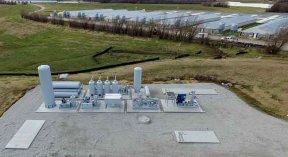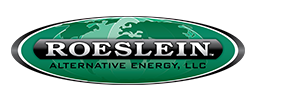Published by Ag Annex
Written by Diane Mettler
What happens when you bring an alternative energy company and pig farms together? Well if the farm owner is Smithfield Foods Hog Production in northern Missouri, which finishes two million pigs a year, and the energy company is Roeslein Alternative Energy (RAE), the answer is a lot of renewable natural gas.

Hog manure from the project will produce approximately 2.2 billion cubic feet of pipeline quality renewable natural gas (RNG) annually, or the equivalent of 17 million gallons of diesel fuel annually (17 million DGE). Photo by Contributed photo
About six years ago, Smithfield (then Premium Standard Farms) was dealing with issues around its sustainable manure management plan. Rudi Roeslein, founder and president of Roeslein Alternative Energy, didn’t see a problem but a potential partnership. His company would capture the methane from Smithfield’s 88 lagoons spread out over nine farms and convert it into natural gas.
“We have a project that makes both economic sense and environmental sense. And we have worked through the technology of how to make it happen,” Roeslein says.
Project is launched
Discussions between the parties resulted in just such a project launching two years ago, with the goal to have the first natural gas-produced pig manure to be injected into an ANR pipeline sometime in the summer of 2016.
The project, although large in scale, is fairly simple in its overall concept. When it’s complete, Smithfield’s farms will have impermeable covers installed on each lagoon. When temperatures are favorable, anaerobic digestion will begin and biogas will be created. The biogas will be filtered/purified (collected and cleaned of sulfur and other impurities) into a gas that is 98 percent methane and has the same molecular composition as natural gas. The cleaned biogas, or renewable natural gas, will be transported underground to an interconnection with the ANR pipeline, and then transported to customers across the country.
When in operation, the hog manure from the project will produce approximately 2.2 billion cubic feet of pipeline quality renewable natural gas (RNG) annually, or the equivalent of 17 million gallons of diesel fuel annually (17 million DGE).
“We cannot look at manure as waste anymore,” Roeslein says. “We have to figure out what we can do with manure to keep it in the cycle. There are no silver bullets. But this is a small step in showing how to use these underutilized resources to produce energy and return everything that remains productively back to the landscape. Because that’s how nature really works.”
Installation of Roeslein Alternative Energy’s biogas technology creates renewable natural gas from Smithfield Foods Hog Production’s two million pigs in northern Missouri and takes sustainability to the next level.
Large demonstration
One of the reasons this project was an ideal demonstration of how the biogas technology can work with the pig industry was location. The ANR pipeline runs across the Smithfield farms.
“RAE has been making very good progress covering the lagoons in a systematic approach,” says Sheldon Ripson, spokesman for Roeslein. “There are 88 lagoons, each approximately four acres [holding 15 million gallons of manure] that need to be covered, with a number of other pieces of equipment to handle the gas being installed along the way. It’s fairly complicated. But they are making steady progress.”
RAE is investing about $120 million into the biogas project. The company anticipates the project won’t just provide renewable natural gas, but also provide hundreds of jobs, and a model for how the swine industry can achieve a more sustainable and profitable business.
Ripson says future partnerships between RAE and other farms will take various shapes.
“Part of the vision here is to show this as a demonstration project on how a system like this can work for handling manure. It’s applicable on any number of operations across the Midwest.”
A recent U.S. Department of Agriculture report said there are thousands of hog operations where anaerobic digestion of hog manure can be economically viable.
“Farmers are busy doing what they do,” Ripson adds. “RAE brings expertise in delivering projects. A company like RAE can fill the gap with a model that makes sense for the producer, both economically and environmentally. Because if you don’t have both of those, it really doesn’t make a whole lot of sense to go forward.”
Simple concept, big benefits
It will take months from the covering of the first lagoon to the last. Methane production, however, doesn’t wait. As the pipelines and purification systems are being installed, the methane is being collected from the first lagoons and being flared off.
Although natural gas isn’t being created yet, Smithfield has already seen some positive effects from just installing the covers. And, the two companies anticipate:
- the prevention of approximately 400 million gallons of rainfall water from entering lagoons
- the elimination of water treatment costs, as rainwater will safely return to the groundwater supply
- the prevention of approximately 850,000 tons of CO2 equivalent methane reaching the atmosphere
- the elimination of hog manure odors
“One of the biggest initial reasons for getting into the project was heavy rainfall that presented an issue with the lagoons,” Ripson explains. “There is a marked improvement with lagoon covers, which keep rainwater out. The rainwater is clean and goes back into the groundwater supply.”
Or the millions of gallons of clean water can be captured to feed hogs or irrigate fields.
Another benefit of anaerobic digestion is the variety of byproducts that can be created from the digestate solids. It can be spread on crops, or it can be used for agriculture, landscaping and public works projects with the benefits of erosion control, water absorption, soil nutrient infusion, and reduction of petroleum-based fertilizer use.
Selling the compost to third parties is something that will be looked into down the road. Currently, Smithfield, which has large tracts of land (approximately 50,000 acres), is pumping the liquid off the lagoons and spraying onto their fields.
Introducing prairie grass
The second phase of this project – and one that RAE is extremely excited about – is the potential of adding prairie grass to the mix. There is plenty of land in the Midwest that is considered either highly erodible or marginal, and where prairie grass is suited to grow. Farms with land that falls into that category could ideally see that land becoming profitable versus a liability, and provide habitat for wildlife.
“We are looking at native prairie restoration opportunities to produce additional feedstock to increase energy output. It improves the economic model of the project,” says Chris Roach, director of Roeslein Alternative Energy. “But that land restoration is also how we create more habitat and ecological benefits, which are frankly missing from all other models of producing renewable energy.”
Also, prairie grass is by itself a great fuel source. Restored grassland plantings from multiple species can produce fuels with greater net energy gains per acre than corn or soybeans. And mixtures of native perennial grasses and other flowering plants provide 51 percent more usable energy per acre than corn ethanol.
“It’s not something new,” Ripson says. “Germany has been doing it for some time. They have about 7,000 anaerobic digestion systems that handle waste grasses and other kinds of biomass to generate methane. There’s no reason that can’t happen over here as well by using prairie grass feedstock.”
“It’s a solution that is a win/win for everyone”
Big opportunities
The enormous scope of this project requires both flexibility and patience. Each of the nine locations requires a different set up. Due to that, it’s hard to estimate the final cost. But RAE owner Rudi Roeslein is dedicated to making it happen.
He’s not the only one w
ho sees a big opportunity. There are currently 239 anaerobic digestion facilities in agricultural operations in the United States. And AgSTAR estimates that biogas recovery systems are technically feasible at more than 8,000 large dairy and hog operations.
“The RNG can go right into the pipeline and can be used anywhere across the country once it’s in that pipeline,” Ripson explains. “The company’s first offtake client for this project is Duke Energy in North Carolina. There is already a contract in place and the company intends to take a lot of this gas to help meet its renewable energy requirements.”
There also doesn’t look to be any problem finding future offtake customers, Ripson says.
“There’s an emerging market for renewable natural gas. For example, that market is more established in California where there’s quite a large interest in this kind of thing. The economics are quite favorable for renewable natural gas.
“The technology we have developed is ready to be deployed commercially in a project that makes both economic sense and environmental sense,” Roeslein says. “This is not just about converting the manure from almost two million pigs into renewable energy. It’s about taking environmental sustainability to a new level.”
An overall solution
This summer will be a big milestone for RAE as the RNG created from the two million pigs hits the pipeline. But many see this as only one of its many positive benefits.
“This project will show how farmers can do more than produce food. We can make energy, we can reduce waste, and we can be good stewards for our most important resources – land and water,” says Blake Boxley, director of environmental health and safety for Smithfield Foods Hog Production.
It’s a solution that is a win/win for everyone, Ripson says – the farmer, the energy companies, the offtake customers and the environment.

